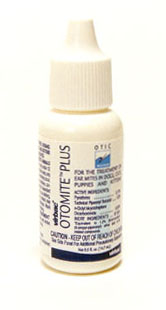
Several ear drops containing aminoglycoside antibiotics can be ototoxic in both humans and pets.

#Otomax side effects in dogs manual#
“High frequencies are affected first, slowing recognition of the toxicity, which may appear at a delay of weeks after treatment has been discontinued.” ~ Merck Veterinary Manual When hearing loss takes place, the signs may not be noticeable at first as the dog’s ability to sense high frequencies is firstly affected, therefore the first signs of hearing loss may become only more noticeable perhaps weeks after treatment. While hearing problems may not be too noticeable, balance problems are known for causing trouble walking, circling, eye jerking movements, tilted head, nausea and vomiting. When these hair cells are damaged, they no longer work as they’re supposed to, thus, communication is broken and the dog may no longer hear well and his balance function may be affected. When a dog normally hears and moves around, the special hair cells located in the dog’s cochlea and the vestibular areas of the inner ear, bend with sound vibrations and movements, thus, relaying information about sounds and movement to the dog’s brain. The drug’s ototoxic effect may be temporary (and thus reversible as the drug leaves the body) or permanent. Ototoxicity therefore may cause a dog’s hearing and sense of balance to be negatively affected. When the vestibular-coclear nerve is instead affected causing balance problems, it’s known as vestibulotoxicity.

Learning more about these ear drops and potential side effects is important so to recognize early signs of trouble and readily report them to the vet.Īs seen in the introduction, the term ototoxicity simply means “toxic to the ear.” How can ears drops be toxic to a dog’s ear? While the process is still not completely well understood, it’s likely a matter of the drugs causing damage to the hair cells in the dog’s inner ear or damage to the nerves responsible for sending a dog’s hearing and balancing information from the dog’s inner ear to his brain.ĭepending on what part of the ear is affected, the ototoxicity may be referred to in different ways. When the coclea (the hearing apparatus) is affected causing hearing loss, it’s referred to as cochleotoxicity. There are certain ear medications that are known for being “ototoxic” which means that they are toxic to the ear and can negatively affect a dog or person’s sense of hearing. Look for discharge or redness within the ear canal and headshaking or scratching around the ears.It may sound quite ironic and surprising that the same ear drops purposely crafted to help a dog recover from an ear ailment, would cause a dog to go deaf, but the risks are real for certain dogs. Thoroughly vacuum areas where pets spend a lot of time.Īfter treatment, continue to check your dog’s ears regularly for signs of ear mites or other problems. Wash items like pet bedding in hot water and then run them through a hot dryer until they are completely dry. In addition to eradicating adult mites, you need to eliminate the eggs that will hatch and later turn into adult mites. If there is a stray neighborhood cat that carries ear mites and interacts with your dog regularly, preventive products (such as Simparica, Nexgard, Bravecto, Revolution, or Credelio) can help ensure that they are not reinfected.

And if there’s also a bacterial or yeast infection, your vet may need to prescribe additional medication or a different medication to address the infection. Sometimes there’s residual debris in your dog’s ear canal that needs to be flushed. These dogs may need another trip to the veterinarian. Most dogs make a relatively quick, uneventful recovery from ear mites, although some dogs might have an ongoing battle with the pesky mites.


 0 kommentar(er)
0 kommentar(er)
